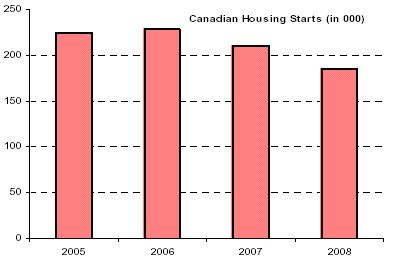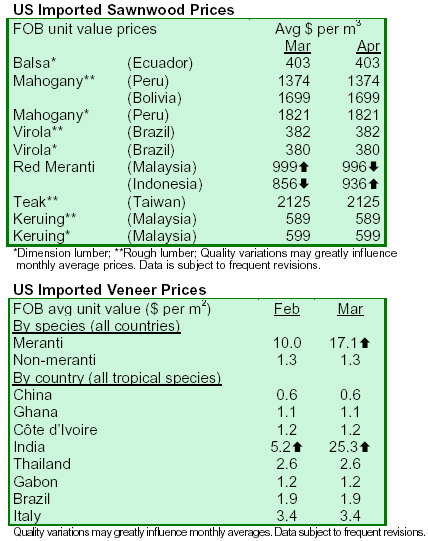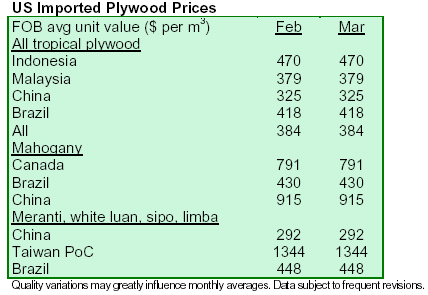|
North America faces sliding demand for lumber
The reduction in North American housing starts resulted in a much lower demand for lumber.
Reductions in the lumber production capacity are needed to balance the supply with the low
demand.
North American lumber usage stood at 72.8 billion board feet (bf) in 2006, down three billion bf or 4% from 75.8
billion bf in 2005. A similar reduction is anticipated for this year, with estimates
anticipated to be below 70 billion bf. Domestic North American suppliers face a demand reduction of close to 5 billion bf of lumber.

The deterioration of the market applies to the entire North
American continent, but there are important regional differences. In the US, overall lumber production will
decline by about 1.4 billion bf or some 3.6% in 2007, or 39.0 billion bf in 2006 to an anticipated 37.6 billion bf this
year. While the southern states are expected to experience only a 2% decline in 2007, the
Pacific region may witness a drop of as much as 5%. Canada¡¯s output fell by only
0.25 billion bf from 34.1 billion bf in 2005 to 33.8 billion bf in 2006, but is expected to decline by a full 1.0
billion bf to 32.8 billion bf in 2007.
American housing starts have been advancing almost without interruption for 15 years, reaching a peak level of
2.07 million in 2005. This enormous construction boom led to an oversupplied
market in 2006, which coincided with a slowdown of the American economy. As a result of
these negative forces, residential housing construction fell by 12.6% last year to a level of 1.81
million units. The haemorrhage in the housing market has not yet come to an
end and sources expect an even steeper decline of close to 20% this year. In 2008, the market may be levelling
off at the low number of approximately 1.47 million units.
The housing market in Canada followed a similar trend, albeit with less severity. Canadian
housing starts culminated last year at 228,000 units but this year they also entered a phase of decline. The decline is expected to
bottom out in 2008 at about 185,000 units. This would be 18.9% below the previous peak level, but this still
compares quite favourable to a drop of 29.0% in the US.
The weak housing segment was somewhat mitigated by healthy repair and remodelling activities and advances in
non-residential and industrial construction.

Source: AKTRIN, Wood Markets Monthly
Canada maintains high exports to the US in 2006
Lumber exports from Canada to the US stood at 20.9 billion bf in 2006. This relatively high
volume was partially triggered by the anticipated enactment of the USCanada
Softwood Lumber Agreement. Canadian suppliers flooded the US market shortly before the implementation
of American import quotas. The deluge of Canadian supplies happened when the demand in the
US slipped. As a result, this had a very dampening effect on prices.
This year, Canadian lumber exports to the US are likely to shrink by some 700 million bf to 20.2 billion bf. Most of
the reduced Canadian lumber exports will affect Eastern Canada, where lumber costs are relatively high. On the
other hand, log and lumber costs in British Columbia are
artificially low due to the significant increase in log availability as a result of the salvage efforts of mountain
beetle-killed trees. In the absence of this salvage effort, Canadian lumber exports to
the US would have dropped much more steeply.
Prices for North American Lumber remain weak
Current conditions in the housing market and excessive saw-milling capacity will cause lumber prices to remain
weak this year and early in 2008. More mill closures and curtailments will be
needed to halt price erosion. Average lumber prices dropped by 16% last year and may slide by
a further 7% to 8% this year. Prices may stabilize in 2008, in conjunction with improvements in the residential
construction industry.
On the positive side, the North American price decline has enhanced the price advantage
against European lumber. North American lumber suppliers are again gaining
competitiveness in international markets. The export business may now yield better returns than domestic sales.
On the other hand, the slump in the US home building industry does not bode well for overseas lumber imports in
the short to medium-term. Since the spring of 2006, exporting lumber to the
United States has become increasingly unattractive for European saw mills as North
American prices have plummeted to nearly half of those in Europe. A noticeable recovery in the American housing
market and a price recovery is not expected before the first quarter of 2008. In 2006,
European lumber supplies have been substantially lower than during the record year of
2005 and indications for 2007 point toward a further decline. Years of market share gains have been
undone.
Brazilian plywood imports plunge 75% in 2007
According to Random Lengths International, U.S. imports of Brazilian plywood fell 75% from the previous year.
While Northeast ports were receiving the bulk of the shipments, supplies entering at Florida slumped in
response to the region¡¯s slowing housing market. The primary reason for the drop in imports were exchange
rates, the 8% GSP duty and increasing transportation costs.


|